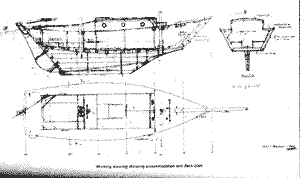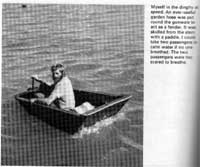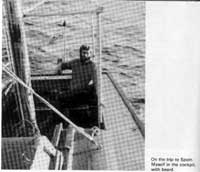Book Review
Erik
the Red
The Atlantic Alone in a Homemade Boat
by Donald Riddler
Erik the Red is a story of an
Oxford graduate, born in Old Trafford, England; who built a
small boat of 26 feet from largely scrap materials and successfully
sailed it across the Atlantic Ocean and back.
 After
some pleasurable experiences around boats and the sea during
his formative years, Riddler left University seemingly unsure
of what to do with his life. He proceeded to do a number of
jobs "...to satisfy myself that I knew how life really
went on." He moved with his parents to Dorset, and worked
for a short while for a farmer who "...eventually and inevitably
gave... the sack." At this stage he had £250 in the
bank and of his father's garden said: "It seemed a convenient
place to build a boat."
After
some pleasurable experiences around boats and the sea during
his formative years, Riddler left University seemingly unsure
of what to do with his life. He proceeded to do a number of
jobs "...to satisfy myself that I knew how life really
went on." He moved with his parents to Dorset, and worked
for a short while for a farmer who "...eventually and inevitably
gave... the sack." At this stage he had £250 in the
bank and of his father's garden said: "It seemed a convenient
place to build a boat."
The boat was to be a 27foot Ketch designed by
T. Rowland of Maine. The hull form was that of a Cape Anne Dory
(the lines are reproduced in the book, and show Riddler's modifications
to the design of the rig). This design was modified to cope
with the limitations of the timber used - mostly from salvage
merchants, or driftwood from the beach, and resources available:
a Junk rig was used in place of the Ketch rig as this was easier
to build cheaply. The boat was built on a framework of railway
sleepers in the garden of the rectory which Riddler's parents
inhabited (his Father was a member of the Clergy), and Riddler
recounts with an apparent fondness the chattering of his neighbours
about this plastic-sheet clad building site inadequately hidden
from prying eyes.

(click to enlarge)
After the trials of the building, including a
troublesome ferro-cement keel, which at first burst, it's mould;
Erik the Red was ready to enter the sea. Erik the Red's time
at harbour was not a happy time, a combination of poor harbour
design features causing damage to his rubbing strake before
ever he left harbour. On the first trial run, the boat ran heavily
against piling with a reporter from a local paper on board,
the second trial run saw Erik badly battered by a storm in the
English Channel, and a rescue operation begun; unsurprisingly
as Erik was at sea for ten days before finally finding shelter
in the far south west of England in Falmouth.
 After
these experiences, Riddler left Erik temporarily and crewed
on two trips moving boats about Europe's Atlantic seaboard,
these provided invaluable experience for him. Riddler's next
voyage was down to Gibraltar, and here again Erik was allowed
to rest while his master crewed for another yacht. While there
Erik's paint was spoiled by oil, and his dinghy destroyed. Riddler
acquired such a tub as would make a Bolger Brick look a graceful
and distinguished craft, to replace the dinghy, and played cat
and mouse games with officious policemen at Sancti Petri in
order to renew the antifouling on Erik. Riddler writes of the
dinghy "I could take two passengers if no one breathed.
The two passengers were too scared to breathe."
After
these experiences, Riddler left Erik temporarily and crewed
on two trips moving boats about Europe's Atlantic seaboard,
these provided invaluable experience for him. Riddler's next
voyage was down to Gibraltar, and here again Erik was allowed
to rest while his master crewed for another yacht. While there
Erik's paint was spoiled by oil, and his dinghy destroyed. Riddler
acquired such a tub as would make a Bolger Brick look a graceful
and distinguished craft, to replace the dinghy, and played cat
and mouse games with officious policemen at Sancti Petri in
order to renew the antifouling on Erik. Riddler writes of the
dinghy "I could take two passengers if no one breathed.
The two passengers were too scared to breathe."
Then it was time to move on again, to Morocco
and on, out into the wide Atlantic. Here Riddler's book changes
somewhat in style. The first chapters having been filled with
the minutiae of building, or the social interactions in port,
or the difficulties of sailing in busy waters with limited knowledge
or equipment. In the vastness of the Atlantic, Riddler's writing
becomes more expansive, in the gaps between the words one can
almost hear the sound of the wind in the rigging and the waves
rushing by. The tale of his trip across the Atlantic is very
much one of battling to encourage Erik to steer himself, and
to maintain sanity and physical condition in an extremely limited
space frequently rocked by squalls.
 On
the 18th of November Riddler landed on Barbados and once more
found himself in a busy dockside world with more characters
to be added to the lists of those encountered in Gibraltar as
he cruised from Barbados to Grenada and on to Antigua. There,
at English Harbour, Riddler found work as an electrical engineer,
which allowed him to save up for his return voyage to England.
On the 14th of June 1971, Riddler sailed regretfully from English
Harbour heading for Bermuda. One hour into the voyage one of
the battens in his sail broke, but was sistered and Erik made
Bermuda without any great dramas, save for making the port of
Hamilton through a seaway cut through coral without a chart.
On
the 18th of November Riddler landed on Barbados and once more
found himself in a busy dockside world with more characters
to be added to the lists of those encountered in Gibraltar as
he cruised from Barbados to Grenada and on to Antigua. There,
at English Harbour, Riddler found work as an electrical engineer,
which allowed him to save up for his return voyage to England.
On the 14th of June 1971, Riddler sailed regretfully from English
Harbour heading for Bermuda. One hour into the voyage one of
the battens in his sail broke, but was sistered and Erik made
Bermuda without any great dramas, save for making the port of
Hamilton through a seaway cut through coral without a chart.
On the 5th of July, Erik the Red was at sea again,
although becalmed off St George's. As he sailed to the Azores,
Riddler had to keep a constant look out to avoid collisions
- the danger he feared most on the voyage. He had been told
to avoid the Merchant Navy as a career and as he remarks: "I
seemed to be spending my time now avoiding the Merchant Navy".
 As
the shipping lanes were cleared the winds became unsure and
the Barometer "came alive". At one stage Riddler writes
that "...50 miles in a day would be good going, and this
was not always in the right direction." this was when the
wind would drive Erik out of the Gulf Stream, and Riddler would
struggle North again to find it. Eventually, he limped into
port in Horta in Fayal, where he repaired sails and rigging.
However, as money became short, Riddler was forced onwards on
the last leg of his journey, which was to be his longest.
As
the shipping lanes were cleared the winds became unsure and
the Barometer "came alive". At one stage Riddler writes
that "...50 miles in a day would be good going, and this
was not always in the right direction." this was when the
wind would drive Erik out of the Gulf Stream, and Riddler would
struggle North again to find it. Eventually, he limped into
port in Horta in Fayal, where he repaired sails and rigging.
However, as money became short, Riddler was forced onwards on
the last leg of his journey, which was to be his longest.
Riddler was plagued initially by light Westerly
winds, and then by stronger winds heading him. Finally, he reached
the latitude of the Lizard Point in SouthEast England and dropped
sail to wait for the prevailing winds. Here Riddler had several
close encounters, twice with Tunny fishing boats, and in a fog
off Cork, with a Tanker. The weather continued to play games
with Riddler as he became increasingly desperate with supplies
of food and fuel rapidly diminishing. On the 21st of September
Riddler made Falmouth, but misjudged wind and tide and was swept
out again before managing to drop anchor; for which mistake
he spent a further three days at sea. On the 23rd of September
he finally dropped anchor in Falmouth harbour. Riddler had arrived
back in England with only two Oxo cubes left for sustenance.
 Following
his return, Erik the Red was displayed at the Boat Show before
being transferred to the then Exeter Maritime Museum. The Exeter
Maritime Museum closed a few years ago, some of the items being
moved to a new Museum in the East of the country. I am reliable
informed that Erik the Red is currently in a warehouse in Scotland.
Where, I do not know. But I hope to find out.
Following
his return, Erik the Red was displayed at the Boat Show before
being transferred to the then Exeter Maritime Museum. The Exeter
Maritime Museum closed a few years ago, some of the items being
moved to a new Museum in the East of the country. I am reliable
informed that Erik the Red is currently in a warehouse in Scotland.
Where, I do not know. But I hope to find out.
Donald Riddler is certainly an interesting character
and writes an interesting and accessible text. This is well
illustrated by plates of the boat under construction and at
various locations around the world. To augment both text and
plates are a healthy selection of diagrams and charts showing
details of the boat and places visited. Most interesting are,
perhaps, the reproductions of the lines drawings of the boat.
There is also an interesting appendix giving details of the
construction of the lead keel which may be of interest to anyone
considering a ferro cement approach to construction, be it the
hull or, as in this case, just the keel.
I would recommend this book to anyone with an
interest in home made boats, particularly those building to
a budget, as it is a great inspiration both in terms of what
may be achieved on a limited budget, but also how it may be
achieved. However, I wish you luck in procuring a copy, as the
book is long out of print!

